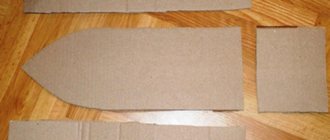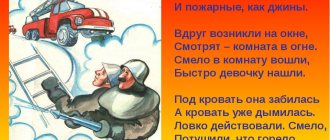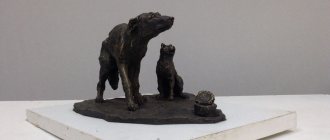Making a paper pumpkin
It’s not at all difficult to make; even a kindergartener can handle the task. This is how they make a pumpkin.
- Take orange, yellow or green colored paper.
- We line it into strips. The width of each strip is 1-2 centimeters (depending on the expected size of the future pumpkin).
- The length of the stripes should be different. The first two stripes are the same length, the next two are 1 centimeter shorter, the next two are another 1 centimeter shorter, and so on.
- We begin to fasten two strips at a time. To do this, they need to be intertwined in the center and secured with glue or a stapler. Add to them the next two strips, fastened in the same way. Then two more, and so on, until the entire craft is assembled.
- On top of the finished pumpkin you can add a leaf cut out of green paper.
The result is a beautiful three-dimensional paper pumpkin.
Making an autumn tree
If you wish, you can even make a whole paper autumn grove.
- First you need to prepare the tree trunk. The best option for this is a toilet paper roll. Or - a tube rolled up from cardboard and glued around the edges.
- We cover the trunk with colored or white paper. If desired, add the missing strokes to it. For example, we paint it like a birch tree.
- Cut out a crown from cardboard.
- The first option is to paint it in different colors with paints. If it is an autumn tree, then it is yellow, red and brown, if it is a summer tree, then it is green.
- The second option is to take paper of different colors and tear it into small particles. Next, apply glue to the crown and glue pieces of paper onto it in random order. These will be the leaves.
- We make a cut on the sleeve (on the trunk) and insert the crown into it. If necessary, fix it with glue or adhesive tape.
That's it, the tree is ready. And if you make several trees, place them on some hill (a cardboard box is best for this purpose), place animals or birds made from cones, nuts or acorns between the trees, you will get a real, wonderful grove.
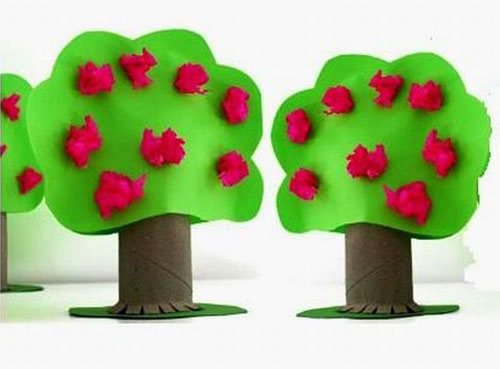
Another autumn tree
It is done a little differently, but the end result is a craft of amazing beauty.
- Cut out a trunk and branches from brown paper.
- Glue them onto a sheet of colored cardboard. The color can be any, the main thing is that the trunk does not get lost against its background.
- Take yellow, brown, orange, red and green paper and cut it into strips.
- Using glue, we make circles from the strips. These are the leaves of a paper tree.
- We make a tree crown from circles (leaves), gluing them on top of the trunk and branches.
- Cut out two green or yellow strips and glue them to the bottom of the tree. This is autumn grass. For a more autumnal mood, glue several circles to the grass. These are leaves that have fallen from a tree.

In addition, the video will tell you how to make autumn trees from paper. Here it is.
Making paper leaves
Well, it's quite simple.
- Draw a tree leaf on colored paper. Any: maple, oak, apple - whatever you like. Then we cut it out with scissors.
- Is it difficult or don’t you want to draw? It doesn’t matter: with the help of adults or on our own, we find the sheet on the Internet and print it on a color printer as many times as we like.
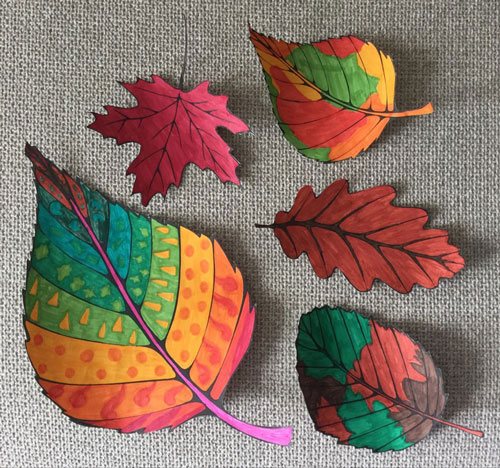
This video will tell you more about how to make maple leaves from paper.
Paper leaves are beautiful in themselves, and they can also be used to make a wonderful autumn garland. For it, the leaves need to be made colored on both sides, otherwise the garland will not turn out to be any beautiful.
This is how a garland is made. The leaves are attached in random order to a strong thread. They can be strung on a thread, glued, sewn - in general, whatever is more convenient. The more colorful leaves there are on the garland, the more beautiful the garland will be. It can decorate any room. Paper leaves, unlike real ones, are stored for a very long time.
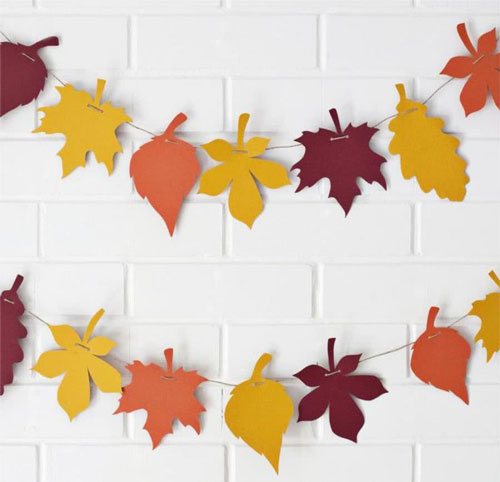
Paper leaf templates
Autumn print
This activity is especially fascinating for children; they make crafts with pleasure, so you should definitely do it. Moreover, there is no difficulty here. On the contrary, everything is simple, bright, fun.
- We cover the table with paper or oilcloth, because we will have to deal with paints.
- We prepare real, large and durable autumn leaves. It’s better to use different trees, it will be more interesting.
- Apply a thick layer of gouache to any color you like on the sheet. We experiment with paints - this develops creativity in the child.
- Press the painted sheet onto colored or white paper. An imprint of the sheet will appear on the paper. It can be cut out (when the paint dries), or you can make several prints on one sheet. The end result is a beautiful autumn picture.
- The missing details on it are completed with felt-tip pens or paints.
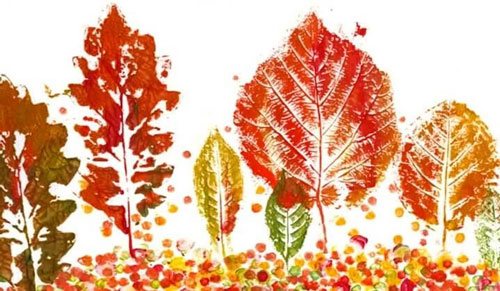
Making an autumn rainbow
To make such a craft, you need to stock up on:
- cardboard of various colors;
- scissors;
- glue stick;
- cotton wool;
- stapler.
Let's start making a rainbow.
- We cut seven strips from colored cardboard. Moreover, in a strictly defined order: red stripe, orange, yellow, green, blue, indigo, violet. If the child does not understand the essence, he should be explained that this is the order in which the colors on a real rainbow are arranged.
- When cutting out strips, you should also take this point into account. The red stripe should be the largest, the orange one should be slightly smaller, the yellow one should be even smaller, and so on. The smallest should be the last, purple stripe.
- We arrange the stripes in the appropriate order, starting with red (top), continuing with orange, yellow, green, blue, indigo and ending with purple (lowest). The stripes should not be even, but in the form of an arc.
- We fasten the strips together with a stapler.
- We make clouds from cotton wool and glue them to the sides of the rainbow.
A beautiful autumn rainbow is ready!
This is just a small part of autumn crafts made from colored paper. And there are an infinite number of them. Create!
Craft ideas made from colored paper
What kind of work do people do in the field in the fall? Autumn fertilizer.
Autumn work in the garden and vegetable garden necessarily includes the application of fertilizers and various nutritional supplements. At different times, plants in the garden need different ratios of nutrients. In autumn, increased levels of phosphorus and potassium are required. These macroelements contribute to good ripening of wood, the accumulation of substances necessary for overwintering and a good spring start, have a positive effect on root growth and the formation of a future harvest, and increase plant resistance to certain diseases. They are also useful for improving the taste of fruits and their intense coloring.
But nitrogen fertilizing in the fall must be excluded. This element provokes untimely growth of shoots and makes it difficult for wood to ripen. As a result, without having time to prepare for the cold, trees and shrubs are easily damaged even by slight frosts.
Fertilizers can be applied in both liquid and dry form. The fertilizer solution is prepared according to the instructions (the recommended concentration should not be exceeded) and the plants are watered at the roots. Foliar feeding is not carried out in the fall: the leaves at this time are coarse, protected by a dense covering tissue that is practically unable to allow various substances to pass through.
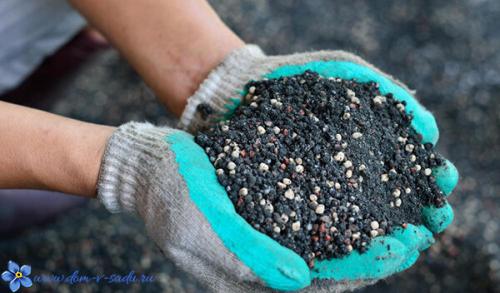
Dry fertilizers are evenly distributed throughout the tree trunk circle, after which the soil is shallowly dug up or loosened. Good results are obtained by applying fertilizers to the holes. To do this, make 3 - 4 holes 20 - 25 cm deep around a tree or bush, the required dose of fertilizer is evenly distributed over the holes, and the holes are buried. Do not make holes too close to the trunk: fertilizers are absorbed only by absorbent roots. They are located approximately along the perimeter of the crown. After applying dry fertilizers, the plants must be watered.
Fertilizers should not be left on the soil surface: potassium and phosphorus slowly move deeper into the soil, and phosphorus is easily absorbed by soil particles, becoming inaccessible to plants.
If the soil in the garden is acidic, deoxidizers (dolomite flour, lime, chalk) are added. It is useful to add ash. It is not only a good deoxidizer, but also a source of ash elements. But first, to determine the norm, determine the acidity of the soil in your garden.
The appropriate doses of the drug are indicated on the packaging. It is advisable to check the acidity of the soil annually, because most mineral fertilizers contribute to acidification of the soil.
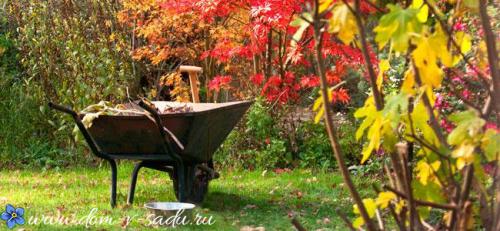
Preview:
Summary of the educational situation “Farm estate”
Teacher of the first qualification category Efimova Alla Petrovna
— enrich children’s design and construction experience when using different building materials
— consolidate the lexical topic “domestic animals and their young”
- train mental operations - analysis, comparison, generalization, develop attention, speech.
Preliminary work: talking about domestic animals, asking riddles, looking at pictures, building farms for animals.
Didactic objectives: To evoke the internal need of children to be included in activities.
The teacher gathers the children around her and holds a box of pet toys in her hands. Children look at the animals and call them babies.
-Guys, how can all these animals be called one concept?
- why are they called that?
- Because they live next to a person.
— Guys, this morning I received an email asking for help, listen: “Help, help!” Winter is coming soon, and my pets have nowhere to live. Help build a farm estate » And that’s it, there’s not even a signature. Who do you think it could be?
Listens to all answer options, the teacher repeats the correct answer - farmer.
— Do you want to help the farmer? (Yes). Can you help?
Children and their teacher approach the interactive board.
Educator: Guys, I’ll now show you the pictures that came with the letter, and you look carefully and answer my questions. (children look at pictures depicting farms, haylofts, stables, sheds, paddocks...)
The teacher concludes: for each animal there is a certain type of building.
The teacher and the children approach the table on which there are diagrams of buildings.
A difficulty arises because the children are not familiar with the concept of a farm estate.
Educator: Were we able to help the farmer? Why couldn't they? (because we don’t know what a farm estate is). Do you want to know? What do we need to know? (what is a farm estate)
What should you do if you don’t know something? (ask someone who knows)
Ask! (Children ask the teacher).
Educator: a farm estate is a piece of land for permanent residence on which a family can build their house, plant a garden, a vegetable garden, build outbuildings for their animals, can fence their estate or plant trees around it.
Can we help now? (Yes).
Didactic objectives: to enrich children’s design and construction experience: building a farm estate according to plan.
Choose your own material for construction: Kostya chooses gray-haired assistants to build on the carpet with a large wooden construction set; Danil chooses his assistants to build on the carpet with a Lego constructor;
Lisa chooses her helpers for construction at the table with a small wooden construction set (children are divided into mini-groups, choose their own building material and pet toys).
In case of difficulty, the teacher asks questions: “Where will your cows live? And the horses. )
The teacher praises the children for their excellent work. Takes photos of the final result to send the photo to the farmer to select a farm estate.
Didactic tasks: to reflect on activities in class, to create a situation of success.
The teacher invites the children to sit on chairs and invites one representative from each group.
Children talk about their construction, show what is where and what it is intended for.
- why were you able to help? (Because we know what a farm estate is)
Technological map of the educational situation "Farm estate"
Source
What do people do in the fall? What do people do in the fall?
Hello, dear visitors of our blog!
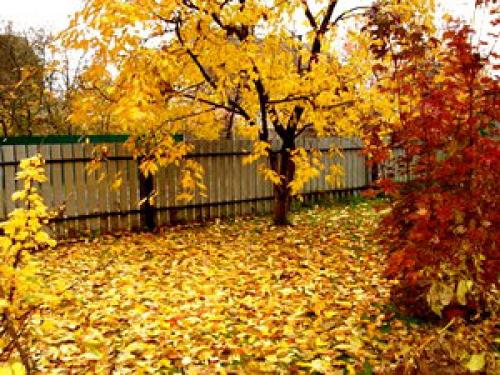
The month of August is coming to an end, and with it summer. And we are gradually moving to the theme “Autumn”. Let's start with a new post about what people do in the fall and how to tell your child about it. A presentation on this topic will be released a little later.
In autumn, people have a lot of worries and a lot of work. After all, autumn is harvest time.
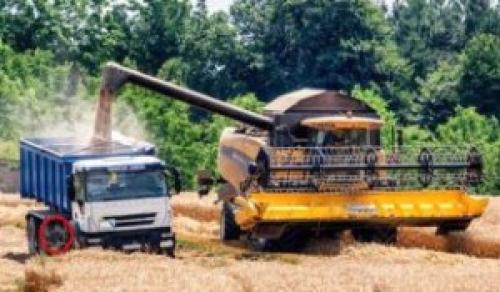
It is in the fall that many fruits and berries ripen in the gardens - plums, apples, pears, rowan berries, wedges and others.
The harvest is underway in the fields. Bread is harvested with special machines - combines.
And vegetables ripen in the garden - beets, carrots, potatoes, cabbage, zucchini, peppers and so on. You need to have time to collect the entire harvest from
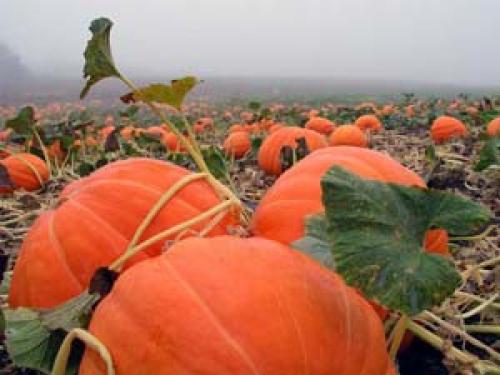
vegetable gardens, orchards and fields, and prepare it for long-term storage in winter.
In autumn, many people flock to the forest for autumn gifts - mushrooms and berries. The following mushrooms ripen in the forest: honey mushrooms, boletus, boletus, porcini, and russula. And berries - cloudberries, lingonberries, cranberries.
In the fall, it’s time for housewives to prepare fruits, berries, vegetables and mushrooms for the winter. They ferment, salt, dry, preserve,
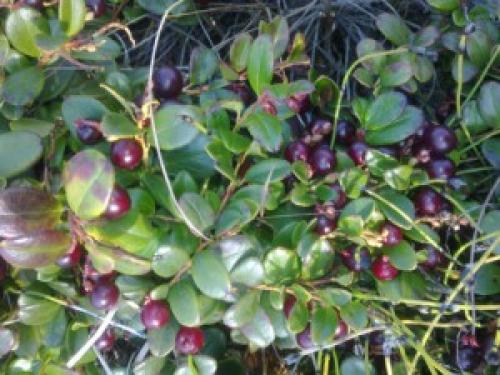
they freeze - in a word, they make supplies for the long winter and spring.
And in the fall you need to prepare the soil in the fields and gardens for winter. Before spring, the soil must rest - it is dug up and useful substances - fertilizers - are added. And they do this just before winter, in order to prepare the land for spring planting and reap a good harvest next fall.
Also, the plowed soil will freeze well during the winter and in it
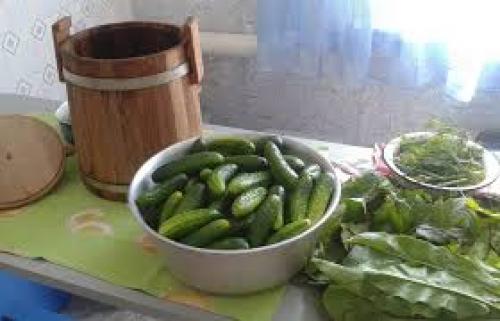
More harmful insects and weeds will die.
Did you know that in the fall they not only harvest crops from fields and gardens, but also plant new plants - garlic, parsley, winter rye and wheat, etc.
It is better to replant seedlings of trees and shrubs in the fall.

Also, in the fall, people clean their yards and streets - after all, so many leaves fall from the trees in the autumn. And the tree trunks below are whitened with lime so that in winter the hares will not strip the bark from them.
There are so many interesting things you can tell your kids about what people do in the fall.
You can download an illustrated presentation with this text here.
Sincerely. Elena Medvedeva.
The work of people in the field. Educational project “People’s work in nature in spring”
Maria Yatsenko Educational project “People’s work in nature in spring”
Topic of the week: “People’s work in nature in spring”
Goal: To form initial ideas about the spring work of people in nature.
Getting to know the profession of a gardener, observing the work of a janitor.
Observing the planting of seeds of flowering plants and vegetables in the beds.
Create a desire to help adults.
Foster respect for the work of adults.
Conditioning: Kitten toy
Album about professions
Interaction with parents and society: organizing a cleanup day together with parents.
Final event: “Subbotnik”
Direct educational activities Joint organized educational activities
• Cognition
Topic: "People's work"
(Green milk p. 106)
• Design/application
Topic: “Birdhouse” (Komarov page 76)
Teach children to depict objects consisting of several parts in appliqué. Improve your knowledge of colors. Develop color perception.
• Communication:
Topic: “Examining the painting “People in the Garden”. Sound culture of speech: sound s, z” (Gerbov p. 75)
Practice clear pronunciation of sounds with Exercise children in the ability to conduct a dialogue.
• FEMP
Topic: “Left, Right” (L. G. Peterson, E. E. Kochemasova Playing game p. 80)
To consolidate the ability to understand and use the words “left”, “right”, “in the middle” in speech, to form an idea of the position of an object to the right and left of oneself.
Artistic creativity:
- Drawing
Topic: “Shovel and rake”
(Koldina p. 43)
Teach children to draw objects consisting of a combination of lines; draw objects large, placing images over the entire surface of the sheet.
— Modeling
Topic: "Trolley"
(lesson notes)
Physical development
Topic: Lesson 15
Goal: to teach different ways of walking.
Train in alternating running, walking, and formation at the instructor’s command.
Develop motor activity and observation skills.
Summary of a design (origami) lesson in the preparatory group “Crown for Autumn”
Info lesson › Fine Arts, MHC › Notes › Notes of a lesson on design (origami) in the preparatory group “Crown for Autumn”
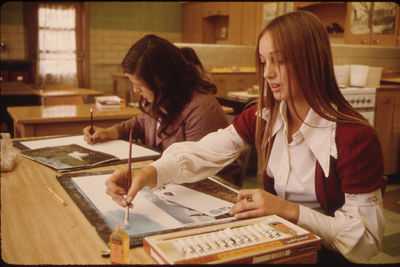
Refresher course
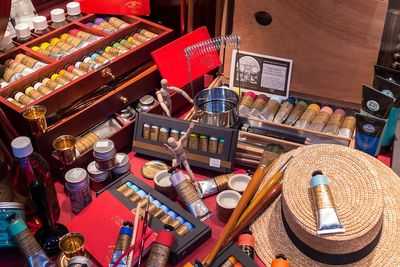
Professional retraining course
Teacher, fine arts teacher
Refresher course

Find material for any lesson by indicating your subject (category), class, textbook and topic:
Select a category: All categoriesAlgebraEnglishAstronomyBiologyGeneral historyGeographyGeometryDirector, head teacherAdditional educationPreschool educationNatural scienceArt, Moscow Art Foreign languagesInformaticsHistory of RussiaClass teacherCorrectional educationLiteratureLiterary readingSpeech therapyMathematicsMusicPrimary classesGerman languageLifestyleSocial studiesEnvironmental studiesNatural studiesReligious studiesRussian languageSocial educatorTechnologyUkrainian languagePhysicsPhysical educationPhilosophyFran Tsuz languageChemistryDrawingSchool psychologistEcologyOther
Select a grade: All grades Preschoolers 1st grade 2nd grade 3rd grade 4th grade 5th grade 6th grade 7th grade 8th grade 9th grade 10th grade 11th grade
Select textbook: All textbooks
Select a topic: All topics
You can also select the type of material:
general information
Material number: DB-759698
ATTENTION TO ALL TEACHERS: according to Federal Law N273-FZ “On Education in the Russian Federation,” pedagogical activity requires the teacher to have a system of special knowledge in the field of teaching and raising children with disabilities.
Therefore, it is important for all teachers to improve their qualifications in this area! The distance course “Students with disabilities: Features of organizing educational activities in accordance with the Federal State Educational Standard”
from the “Infour Lesson” project gives you the opportunity to bring your knowledge into compliance with the requirements of the law and receive a certificate of advanced training in the established form (72 hours).
Apply for a course
Similar materials
You might be interested in these courses:
Leave your comment
infourok.ru
